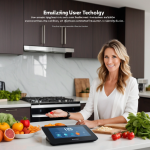Comprehensive Guide: Maximizing Smart Home Connectivity in Kitchen and Bathroom Renovations
Introduction: The Smart Revolution in Kitchens and Bathrooms
The kitchen and bathroom, once relegated to purely functional spaces, are now fertile grounds for technological innovation. From voice-controlled lighting to automated water management, the possibilities for enhancing convenience, efficiency, and even entertainment are vast. However, navigating the ever-expanding landscape of smart home devices and ensuring seamless integration during a renovation can be daunting. This guide provides a comprehensive overview of maximizing smart home connectivity in kitchen and bathroom renovations, drawing on trends and technologies that gained prominence in the last decade (2010-2019) and laying the groundwork for future-proofing your home.
As we embark on kitchen renovation and bathroom renovation projects in 2025, the integration of smart home technology is no longer a luxury but a strategic investment. According to a recent study by Statista, the smart home market is projected to reach $328 billion by 2025, with smart appliances and home automation systems leading the charge. This surge is fueled by increasing consumer demand for energy efficiency, enhanced security, and personalized experiences. Imagine a smart kitchen where your refrigerator alerts you when you’re low on milk, or a smart bathroom where your shower automatically adjusts to your preferred temperature and water pressure.
These are not futuristic fantasies but tangible realities achievable through careful planning and execution. One of the key challenges in creating a truly smart kitchen and smart bathroom lies in ensuring seamless connectivity. Wi-Fi optimization is crucial, especially considering the potential for interference from appliances and plumbing. “A robust and reliable Wi-Fi network is the backbone of any successful smart home integration,” says Maria Sanchez, lead designer at SmartHome Designs Inc. “Before you even think about installing smart lighting or voice control systems, make sure your Wi-Fi can handle the bandwidth demands of multiple devices.” Furthermore, IoT security is paramount.
Protecting your smart home from cyber threats requires implementing strong passwords, regularly updating firmware, and considering a dedicated security system. The goal is to create a connected living space that is both convenient and secure. This Comprehensive Kitchen and Bathroom Remodeling Guide 2025 will delve into the specifics of selecting and integrating smart appliances, automated water management systems, and other cutting-edge technologies. We’ll explore the benefits of voice control, the latest advancements in smart lighting, and strategies for maximizing energy efficiency in your home remodeling project. Whether you’re planning a complete bathroom renovation or a targeted smart kitchen upgrade, this guide will provide you with the knowledge and insights you need to create a truly intelligent and future-proof living space. The aim is to transform your kitchen and bathroom into showcases of innovation, comfort, and sustainable living.
Smart Appliances: Cooking and Cleaning in the 21st Century
The kitchen, the heart of the home, has seen a surge in smart appliance adoption, fundamentally reshaping the culinary experience. Smart refrigerators, offering features like inventory management, expiration date tracking, and AI-powered recipe suggestions based on available ingredients, became increasingly common in the 2010s and are now considered a baseline expectation for many undergoing a smart kitchen renovation. As noted in a 2017 report by the Association of Home Appliance Manufacturers (AHAM), ‘Connectivity is no longer a niche feature but a growing expectation among consumers.’ This trend has only accelerated, with manufacturers now focusing on predictive maintenance and integration with broader smart home ecosystems.
Smart ovens with remote preheating, precise temperature control managed via voice control, and even built-in cameras for monitoring cooking progress, along with dishwashers that optimize water usage based on load size and soil level, further contribute to energy efficiency and a more streamlined kitchen workflow. These smart appliances represent a significant investment in home automation, enhancing both convenience and sustainability. However, the integration of smart appliances into a smart home is not without its challenges.
Early smart appliances often suffered from connectivity issues, limited interoperability, and concerns about IoT security. Addressing these concerns is paramount during any kitchen renovation. Invest in appliances that support open communication standards like Zigbee or Z-Wave, or those that integrate seamlessly with popular smart home platforms like Amazon Alexa, Google Assistant, or Apple HomeKit. This ensures better compatibility, simplifies control through a centralized hub, and future-proofs your investment against obsolescence. Furthermore, consider appliances that offer robust security features, such as two-factor authentication and regular software updates, to protect against potential cyber threats.
A well-planned smart kitchen prioritizes both functionality and security. Beyond individual appliances, consider the broader ecosystem of the smart kitchen. Smart lighting, controllable via voice commands or automated schedules, can create ambiance and improve energy efficiency. Integrated smart scales can track nutritional intake, while countertop gardens can provide fresh herbs and vegetables year-round. The key to a successful smart kitchen lies in seamless integration and intuitive control. A comprehensive kitchen renovation should therefore include careful planning for Wi-Fi optimization, ensuring strong and reliable connectivity throughout the space. Consider installing a mesh Wi-Fi system or strategically placed access points to eliminate dead zones and support the bandwidth demands of multiple smart devices. By thoughtfully addressing these considerations, homeowners can create a smart kitchen that is not only technologically advanced but also a joy to use.
Automated Water Management and Personalized Comfort in Bathrooms
In the bathroom, smart technology is revolutionizing water management and personalized comfort, moving far beyond basic functionality. Automated faucets, for instance, now feature not only touchless operation and precise temperature control for enhanced hygiene and water conservation, but also learning algorithms that adapt to individual user preferences, setting preferred temperatures and flow rates automatically. Smart showers are evolving into personalized wellness hubs, allowing users to customize temperature, pressure, spray patterns, and even integrate chromatherapy and aromatherapy, creating a truly spa-like experience.
These systems can be pre-programmed with individual profiles, accessible via voice control or a dedicated app, ensuring that each user’s ideal shower experience is just a command away. Automated water leak detection systems are also becoming increasingly vital, offering real-time monitoring and immediate alerts to potential plumbing problems, preventing potentially catastrophic water damage and aligning with the goals of energy efficiency and responsible resource management that are central to modern home remodeling. Addressing the inherent challenges of moisture in bathroom environments is paramount for ensuring the longevity and reliable operation of smart home devices.
While ensuring all smart devices are specifically designed for humid environments and carry appropriate IP (Ingress Protection) ratings remains crucial, a more holistic approach is needed. Advanced ventilation systems with humidity sensors can automatically adjust fan speeds to maintain optimal moisture levels, preventing condensation and mold growth. Furthermore, strategic placement of control panels and sensitive electronics away from direct water exposure is essential, and manufacturers are increasingly offering waterproof enclosures and coatings to provide an additional layer of protection.
Consider also the integration of smart exhaust fans that communicate with shower systems, activating automatically when the shower is in use and continuing to operate until humidity levels return to normal, ensuring optimal air quality and preventing moisture buildup. Beyond mitigating risks, smart bathroom technology offers opportunities to enhance energy efficiency and convenience. Smart toilets, for example, incorporate features such as automatic flushing, heated seats, and even bidet functions, all of which can be customized to individual preferences.
These toilets often include water-saving features, such as dual-flush systems and leak detection, contributing to overall water conservation efforts. Furthermore, integrating these devices with a central smart home hub allows for remote monitoring and control, enabling users to adjust settings and receive alerts from anywhere. The increasing adoption of voice control in bathrooms also provides hands-free operation of various features, from adjusting lighting and temperature to playing music and accessing information, enhancing convenience and accessibility, especially for individuals with mobility limitations. This level of integration elevates the bathroom from a purely functional space to a personalized sanctuary, seamlessly blending technology with comfort and well-being.
Lighting, Entertainment, and Wi-Fi Optimization
Beyond appliances and fixtures, smart lighting and entertainment are pivotal in crafting a truly immersive smart kitchen and smart bathroom experience. Voice-controlled lighting systems offer hands-free operation and the ability to tailor ambiance to specific tasks or moods. Imagine preparing a meal in a kitchen bathed in bright, task-oriented light, then dimming it to a warm glow for a relaxing dinner. In the bathroom, smart lighting can mimic natural daylight to aid in makeup application or provide a soft, soothing glow for evening relaxation.
These systems often integrate with home automation platforms, allowing for pre-set scenes triggered by voice control or time of day. This seamless integration of smart lighting is a key consideration in any kitchen renovation or bathroom renovation project aiming for ultimate convenience and energy efficiency. Smart speakers, increasingly compact and waterproof, provide access to music, podcasts, and voice assistants in both the kitchen and bathroom. Beyond simple entertainment, these devices can control smart appliances, provide real-time information (like weather or traffic), and even manage shopping lists.
In the kitchen, a voice-controlled assistant can guide you through a recipe or set timers. In the bathroom, it can adjust the temperature of your smart shower or play calming music. The possibilities are vast, limited only by the capabilities of your smart home ecosystem. When planning your smart kitchen or smart bathroom, consider the placement of these devices to ensure optimal audio quality and voice recognition. Consider the luxury of a waterproof television in the bathroom for entertainment while relaxing in the tub or catching up on news while getting ready in the morning.
However, this highlights a common challenge: Wi-Fi connectivity. Spotty Wi-Fi can disrupt the entire smart home experience, especially in older buildings with thick walls or layouts that impede signal propagation. To ensure seamless connectivity, prioritize Wi-Fi optimization. A mesh Wi-Fi system is often the best solution, extending coverage throughout the entire home and eliminating dead zones. For critical devices like smart TVs or control hubs, consider hardwiring Ethernet cables for a more reliable connection. Regularly update your router’s firmware to ensure optimal performance and security, a crucial step in maintaining IoT security. As the National Institute of Standards and Technology (NIST) emphasizes, proactive software maintenance is paramount for mitigating vulnerabilities in connected devices. Prioritizing robust Wi-Fi infrastructure is essential for any successful home remodeling project incorporating smart technology and smart appliances, particularly in moisture-prone environments like kitchens and bathrooms, where device longevity depends on careful planning.
Conclusion: Building a Future-Proof Smart Home
Integrating smart technology into kitchen and bathroom renovations presents a transformative opportunity to enhance convenience, energy efficiency, security, and entertainment. Thoughtful planning is paramount, beginning with selecting devices that are interoperable and compatible with your existing smart home ecosystem. A successful smart home renovation, especially within the moisture-prone environments of kitchens and bathrooms, hinges on professional installation practices and a commitment to ongoing maintenance, including timely security updates to safeguard against emerging IoT security threats.
Prioritizing devices that support robust encryption and regular firmware updates is crucial for maintaining a secure and resilient smart home environment. This proactive approach ensures that your investment remains protected against potential vulnerabilities. Looking ahead to 2025, the convergence of smart appliances and advanced home automation systems will redefine the kitchen and bathroom experience. Expect to see further integration of voice control, enabling seamless operation of lighting, temperature, and entertainment systems. Automated water management systems will become increasingly sophisticated, offering precise control over water usage and leak detection, contributing to significant gains in energy efficiency and water conservation.
These advancements will not only enhance the functionality of these spaces but also contribute to a more sustainable and eco-friendly lifestyle. The smart kitchen, in particular, will evolve into a hub for personalized culinary experiences, driven by AI-powered recipe recommendations and automated cooking processes. Wi-Fi optimization is another critical aspect of a successful smart kitchen and smart bathroom integration. Ensuring a robust and reliable Wi-Fi network is essential for seamless communication between devices and the cloud.
Consider deploying mesh Wi-Fi systems or strategically placed access points to eliminate dead zones and provide consistent connectivity throughout the renovated spaces. Furthermore, exploring the potential of edge computing can reduce latency and improve the responsiveness of smart devices, especially in areas with limited bandwidth. As home remodeling trends shift towards interconnected living spaces, optimizing Wi-Fi performance becomes a non-negotiable aspect of any comprehensive smart home upgrade. Staying informed about the latest wireless technologies and adapting to new innovations will ensure that your smart kitchen and bathroom remain at the forefront of home technology for years to come.


